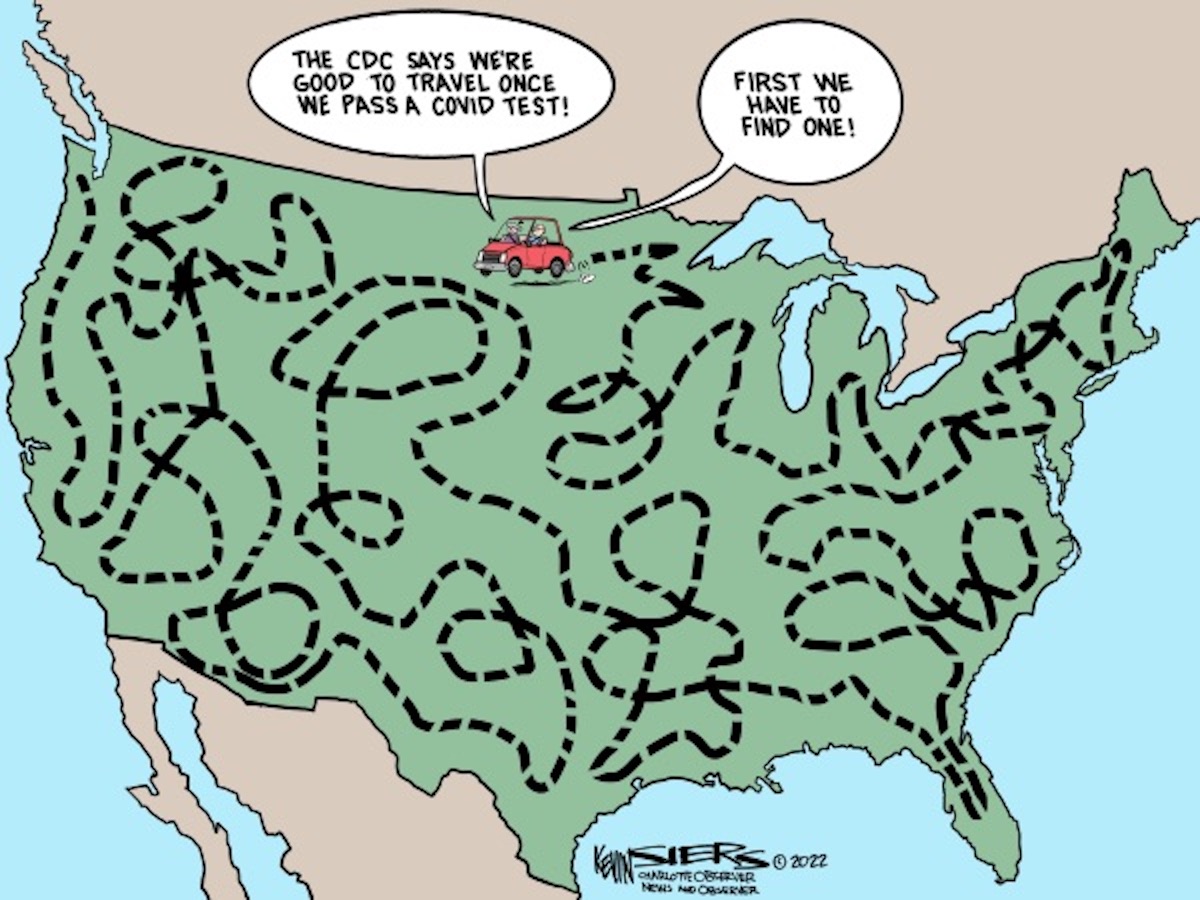The COVID Testing Desert
One Public Health Doctor's Experience

Flat or declining spending on prevention has left the United States ill-equipped to respond to COVID-19 (Health Affairs).
We picked my son up at Union Station in Los Angeles on December 21 after his 2.5-day flygskam train trip from the University of Michigan. Then we headed off for a few days of hiking and birdwatching in the desert. On the way, he told me he had developed some mild cold symptoms while on the train.
Early that evening, we arrived in Desert Hot Springs. When he said he had a bit of congestion in his chest, I knew what had to be done. I searched for a COVID-19 rapid test. “Sold out. Come back in a few days,” the cashier at the first pharmacy said. I found a BinaxNOW™ COVID-19 Antigen Self-Test (Abbott) at another pharmacy and went back to our motel to test him. It was negative. Knowing the rapid tests don’t always detect COVID, I searched the internet for a place to get him a PCR test. The internet results were dominated by the COVID clinic at the Palm Springs Airport. Reading on, they said the clinic “provides a no-cost-to-patient diagnostic COVID-19 PCR test for eligible insured, uninsured, and undocumented patients.”
We arrived just after the airport’s COVID clinic opened on December 22. After waiting in the drive-up line for 30 minutes and seeing another 30-minute wait ahead of us, I walked up to the front of the queue and saw a small sign that said “By appointment only.” The human directing people to their test confirmed that we needed to go online and sign up, and that once we made an appointment and made our way to the front of the car queue, we could get results in three hours for $299 or three days if we didn’t want to pay.

As we drove off and looked for a place to stop, connect, and sign up for the PCR test, we passed an old pickup truck parked on the side of the road with a sign saying “Free COVID Tests.” Suspicious that there were only two people in line, I sent my son to check them out. They were from SOSYES, in San Diego County. They took a picture of his student ID and driver’s license, had him cough spit into a vial, labeled it, put it in a cooler, and said it would be two to three days.
We returned to Santa Barbara three days later after driving with the windows closed through the rainstorm. On December 24, he got a text message from SOSYES that said “positive PCR,” accompanied by a photo of the test result.
Although my wife and I were fully vaccinated, boosted, and asymptomatic, we had been intensely exposed to him for five days before the PCR came back. So, not wanting to take any chances, we looked up where to get a PCR on Christmas Eve. The County Health Department website directed us to LHI.care. The next available date was the December 27 in Goleta in the Direct Relief parking lot.
When we arrived for the testing, a handwritten sign said “Closed due to staffing shortages” and listed an 800 number to call to reschedule. We called, and after a 20-minute hold, we were told the Goleta testing station had closed due to 10 inches of snow in Truckee. LHI.care said there were no appointments available in South Santa Barbara County through at least the end of the second week of January (when their appointment calendar ended). They found testing was available in Ventura on December 30 but advised us that the results would take five more days because they were inundated with testing requests. We gave up, knowing that the results of the PCR would be too late to shorten our 10-day quarantine.
What we wanted to know is (1) if we had COVID, and (2) if we were infectious.
On December 28, an FDA statement hinted at the problem. “Early data suggest that rapid tests detect the Omicron variant but may have reduced sensitivity.” A study from the COVID-19 Sports and Society Working Group was more forthcoming, concluding that most patients with Omicron were infectious for several days before being detectable by rapid tests. A study from South Africa concluded that, for PCR, saliva samples are more accurate valuable than nasal samples for detecting Omicron infections.
In the meantime, the CDC changed their recommendations for fully vaccinated people, allowing me and my wife to leave quarantine, as we never developed symptoms.
The study in Health Affairs found that while national health expenditures (which are primarily for curative services) grew by 4.3 percent between 2008 and 2018, state government spending and public health spending saw no statistically significant growth.
To do this, we need to support our county’s prevention service and nonprofits that provide free and convenient prevention and early diagnostic services, such as SOSYES.
Daniel B. Fishbein, MD, is a retired captain in the United States Public Health Service.




You must be logged in to post a comment.